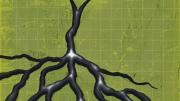When people think of mercury, says Daniel Jacob, they tend to think of the element in its silvery, fluid state—the stuff to avoid if a thermometer breaks. “It’s a fascinating metal in that it is liquid at room temperature, but it is present in the atmosphere as an elemental gas,” says the Vasco McCoy Family professor of atmospheric chemistry and environmental engineering. “It’s really amazing.”
Amazing, but potentially very dangerous. At high levels, mercury is a toxin that can impair neurological development in children and affect the adult nervous system. Jacob has been studying the movement of atmospheric mercury for the last decade or so, and has been particularly interested in how and why it shows up at elevated levels in the Arctic—in both the atmosphere and the food cycle. Conventional wisdom, he says, was that emissions from coal combustion and mining in North America, Europe, and—increasingly—Asia were drifting over the Arctic and depositing the mercury via precipitation.
A few years ago, he began testing that theory using a complex 3-D computer model called the Geos-CHEM, which measures atmospheric transportation. “What I was expecting was to find that atmospheric deposition was the dominant source of mercury to the Arctic,” says Jacob. With that finding, he could then examine how that deposition was affected by changes in global emissions patterns—rising levels in Asia, falling levels in the United States and Europe—and by the melting of the Arctic sea ice, which receives and re-emits the mercury into the atmosphere, keeping it from further dissemination in the water. “But, as often occurs in science,” Jacob says, “serendipity took over.”
When he and research teams from the Harvard School of Engineering and Applied Sciences and Harvard School of Public Health started analyzing their data, they found something the emissions theory could not explain: mercury levels in the Arctic peaked in the summer, when the transportation of emissions pollution was low, but fell off during the winter, despite a concurrent annual emissions-pollution peak.
The hidden element? Their study, published in a recent issue of the journal Nature Geoscience, found that the major Arctic mercury source wasn’t the atmosphere, but the Arctic Ocean itself.
That body of water, Jacob says, receives 10 percent of all global river discharge, thanks in large part to three massive Siberian rivers: the Lena, the Yenisei, and the Ob. Jacob’s team theorizes that the rivers carry mercury to the Arctic Ocean from myriad sources, including Siberian mines and the erosion of other polluted land masses—and because the ocean is relatively shallow, the mercury-laden river waters have a greater influence on its smaller volume of water.
Climate change is another culprit. An unfrozen Arctic Ocean lashing at the coast and eroding mercury-rich land masses means more of the element entering the water, especially in summer. The effect of rising temperatures in Siberia eventually affects the Arctic, as well: “As the permafrost thaws, mercury in the soil gets released into the river system,” Jacob explains. “From a policy standpoint,” he adds, “the message is that the mercury accumulation is not necessarily a recent phenomenon, and we can’t really blame increasing pollution from China—which is what people wanted to do. It seems to be really old mercury, and it’s coming from really old human activity”—such as mining—“that is a century old, maybe older.”
When that mercury enters the marine ecosystem, it can accumulate in fish in concentrations as much as a million times higher than the element’s oceanic or atmospheric levels—posing a serious risk to indigenous human populations in the Arctic who rely on the fish as a food source. What’s next, Jacob says, is to chart Arctic mercury’s course. He and his team will use their study results to plot how the accumulation has changed during the past 30 years and use that data to predict what challenges Arctic inhabitants might face in a warmer future.









